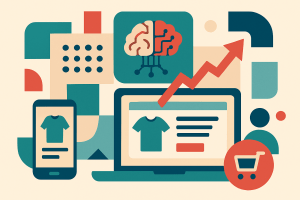
Activating Insights in the AI Era: A Practical Guide for Creative Leaders
Unlocking the Power of AI Insights
Transform Your Creative Strategy with Data-Driven Decisions
Understanding AI Insights and Their Implications for Business Growth
In today’s fast-paced market, the ability to leverage AI insights has become critical for creative directors and marketing leaders alike. These insights are generated through advanced data analytics and machine learning algorithms, offering a treasure trove of information that can significantly influence decision-making processes. For instance, brands like Netflix utilize AI to analyze viewer behavior, while Amazon employs algorithms to tailor recommendations, exemplifying how data-driven marketing leads to increased customer engagement and sustained business growth.
The implications of effectively activating these insights extend beyond mere analytics. By embedding AI insights into your creative strategy, you can foster a culture of innovation within your team. This proactive approach cultivates an environment where data informs creativity, empowering teams to develop campaigns that resonate deeply with target audiences. When insights are actively utilized, marketing strategies become not just reactive but predictive.
However, achieving successful implementation can appear daunting. Many leaders feel overwhelmed by the volume of data and technological tools available. It can be unclear where to start or how to integrate these insights into daily operations. This guide aims to demystify the process, providing you with actionable steps to integrate AI insights effectively into your marketing efforts.
Real-World Examples of Insight Implementation
To understand the practical application of AI insights, let’s look at a couple of success stories. The first example comes from Coca-Cola, which utilized AI analytics to gather consumer feedback from social media. By analyzing data patterns, Coca-Cola could predict beverage trends and adjust its product offerings accordingly. This proactive stance not only improved customer satisfaction but also increased sales performance significantly.
Another brand worth mentioning is Spotify, which has harnessed AI to personalize music recommendations for its users. By analyzing listening behaviors and preferences, Spotify enhances user experience while simultaneously increasing engagement. This targeted approach to marketing demonstrates a successful activation of insights that directly correlate with business growth.
Common Misconceptions About AI Insights
A common misconception surrounding AI insights is that they are only beneficial for large enterprises with extensive data resources. However, this assumption neglects the fact that even small and medium-sized businesses can harness data-driven marketing strategies effectively. Tools and technologies that utilize AI have become increasingly accessible, allowing smaller entities to analyze consumer behaviors and market trends. These businesses can leverage existing data from customer interactions and social media feedback to make informed decisions that drive growth.
Moreover, the notion that implementing AI insights requires specialized expertise is misleading. While having a data scientist can be beneficial, user-friendly platforms and tools have emerged that enable creative marketers to interpret data without needing advanced technical skills. Fostering a data-savvy team can bridge this gap and help any organization implement AI insights effectively.
Step-by-Step Workflow for Activating Insights
Activating insights involves a structured approach that can yield measurable results. Here’s a step-by-step workflow you can execute this week:
- Identify Key Objectives: Define what you aim to achieve through AI insights. For instance, are you looking to improve customer engagement or optimize ad spend? Clear objectives set the foundation for your strategy.
- Select Relevant AI Tools: Research various AI tools that fit your goals. Look for platforms that offer automated data analysis capabilities. Tools like Google Analytics, HubSpot, or specialized AI tools can provide insights tailored to your needs.
- Gather Data: Utilize existing data from customer interactions, past campaigns, and social media. Ensure you have a repository of relevant data for analysis.
- Analyze Insights: Apply the chosen AI tools to analyze the gathered data. Look for trends and patterns that can inform your creative strategy.
- Implement Changes: Based on the insights gleaned, make informed adjustments to your marketing strategies. This could involve tweaking your messaging, adjusting targeting parameters, or even creating new content.
- Monitor and Optimize: After implementation, track the performance of the changes made. Use KPIs to measure success and make necessary adjustments to enhance outcomes.
Framework for Success
To ensure the successful activation of AI insights, consider employing a framework that encompasses the following areas:
- Data Collection: Consistently gather data from various channels to ensure a well-rounded view of customer behavior.
- Analysis: Invest in tools that simplify data interpretation. The goal is to focus on insights that are directly actionable.
- Execution: Implement changes based on insights swiftly. The market evolves rapidly, and timely execution can lead to significant advantages.
- Feedback Loop: Create a continuous feedback loop. Regularly reassess your strategies using new data insights to stay relevant and ahead of competitors.
AI Platforms That Work with Google Analytics Data
1. Beam AI
Integrates directly with Google Analytics. Automates report generation, finds trends, and hands you insights instead of making you dig. No fluff.
2. BigQuery + Vertex AI (Google Cloud)
Not a single “platform,” but a powerhouse combo. You pull GA data into BigQuery, then use AI via BigQuery ML or the Vertex AI stack for forecasting, sentiment analysis, anomaly detection, and more. Powerful but needs actual setup and some SQL or BI skills.
3. Relevance AI (Google Analytics AI Agents)
This one pretends to be your digital analyst. It monitors metrics, creates segments, forecasts trends, responds to plain-language queries, flags anomalies, and builds reports. Also pulls in other data like CRM or social media for context. Sounds like magic until you test it—but still legit.
4. Google Analytics’ Native “Analytics Intelligence”
GA itself comes with built-in AI features. You can ask questions in natural language, and it surfaces automated insights and anomaly alerts. Not the fanciest tech, but it’s free and already part of the platform.
5. CaliberMind, SEMrush, Pecan AI
From an analytics mates source:
-
Pecan AI taps into GA4 data for forecasting.
-
CaliberMind connects GA4 to broader data and BI.
-
SEMrush isn’t GA-specific, but its AI tools can detect odd website traffic shifts and tie that back to GA. Not a plug-and-play GA tool, but useful if you’re already using it.
Defining KPIs and Common Pitfalls
Establishing clear Key Performance Indicators (KPIs) is essential for measuring the success of your insights implementation. KPIs might include metrics such as customer engagement rates, lead conversion rates, or return on investment (ROI) from newly implemented campaigns. Ensure that the KPIs align closely with your initial objectives, as this will provide a clear path for assessment.
Common pitfalls to avoid include data paralysis, where an excess of information leads to indecision. Focused analysis based on key objectives will help prevent this. Moreover, neglecting to act on insights can diminish the value of the data gathered. Consistent application reinforces the significance of ongoing data use in achieving desired results.
Your Next Steps for Activating AI Insights
As a creative leader, taking the initiative to activate AI insights in your organization can lead to remarkable improvements in your marketing efforts and overall business growth. Start by adopting a mindset that embraces data-driven decision-making. Equip your team with the tools and training necessary to utilize insights effectively. Don’t hesitate to experiment with new strategies based on the data you’ve gathered; this will cultivate a culture of innovation.
Now is the time to put these insights into action. By following the steps outlined above and maintaining a focus on continual improvement, you will position your brand for sustained success. Engage your team, harness the power of data, and transform your marketing strategies. The future is bright for businesses that leverage the full potential of AI insights.


